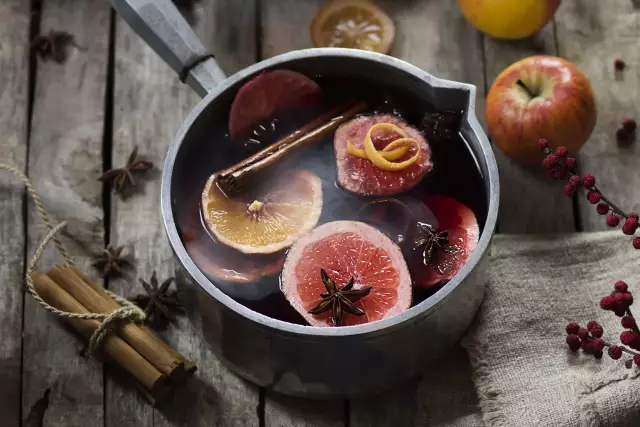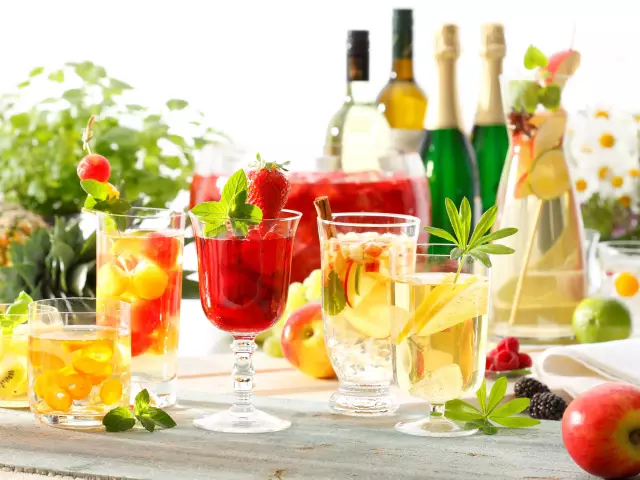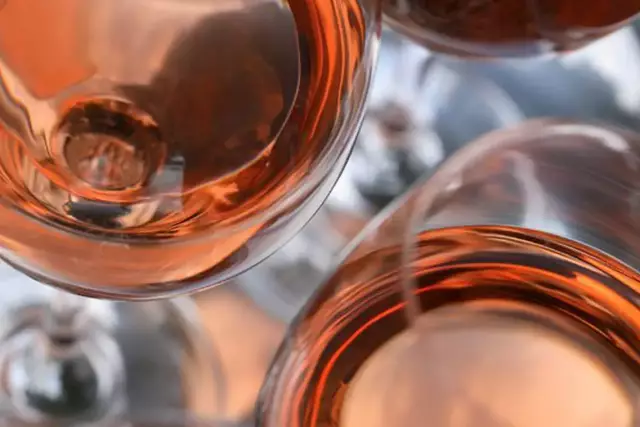Secco

Secco can be a light alternative to sparkling wine whenever you feel like celebrating with others.
Facts
-
6 - 8° degrees
are ideal drinking temperatures
-
< 35 g/l
of residual sugar is considered as "dry"
-
1 - 2,5 bar
pressure
With relatively low alcohol, a Secco is recommended as an ideal summer aperitif, which does not put as much strain on the body even in hot temperatures. Served cool at around 6-8 ° C, it is particularly refreshing. Seccos are now part of the standard repertoire for many German winegrowers.
How is Secco different
According to German Wine Law, semi-sparkling wine is defined as wine which has an excess of carbon dioxide compared to still wines. While most of the CO2 escapes during the fermentation of grape must to wine, for the preparation of high-quality Seccos, this is captured and put back into the wine after fermentation.
If CO2 from sources other than the wine itself are added, then it must be declared as "semi-sparkling wine with added carbon dioxide." This carbonation method is only used in the simplest semi-sparkling wines. Seccos have only 1 to 2.5 bar pressure, while sparkling wine contains at least 3, and up to 6, bar of carbonic acid pressure. An important distinction between seccos and sekt, or sparkling wine, is that in the latter, the CO2 comes from a second fermentation.
Seccos don’t need to use a wire cage (muselet) over the cork, like with sparkling wine, but are mostly closed with either a screw cap or a cork with foil or string.
Levels of sweetness for semi-sparkling wines
Dry: up to 35 g / liter residual sugar content
Semi-dry: 33 - 50 g / liter residual sugar content
Mild: > 50 g / liter residual sugar
Is Secco the same as Prosecco?
No! Prosecco comes from Italy, is pressed from the Glera grape variety and may only be produced in the DOC Prosecco. It is available as sparkling, semi-sparkling and still wine. Meanwhile in Germany, Secco is a sparkling wine with technically added carbon dioxide.
Varietals

More recipe ideas
in a bacon coating Lamb
in a bacon coating
- 4 Stück Lammlachse à 150 g
- 4 Scheiben Bacon
- 0,1 Liter Wein
- 0,3 Liter Gemüsebrühe
- 1 kleine Schalotte
- 20 Gramm Butter
- 4 EL Olivenöl
- je 2 Zweige Thymian, Rosmarin, Salbei
- nach Geschmack Salz & Pfeffer
Season the lamb salmon with pepper and massage 2 tbsp of olive oil into the meat. Finely chop the thyme, rosemary and sage and season the meat in the herbs. Marinate in the fridge for a few hours.
<p
<p>Wrap the meat with the bacon slices and sear on all sides in the remaining olive oil. Continue to cook for approx. 4 minutes on each side over a low heat (the cooking time depends on the thickness of the lamb loin - it is best to do a pressure test). Then wrap in aluminium foil and leave to rest in the oven at 80 °C – so they remain juicy and slightly pink on the inside.
This goes well with Bärlauch risotto.
- Dornfelder (trocken)
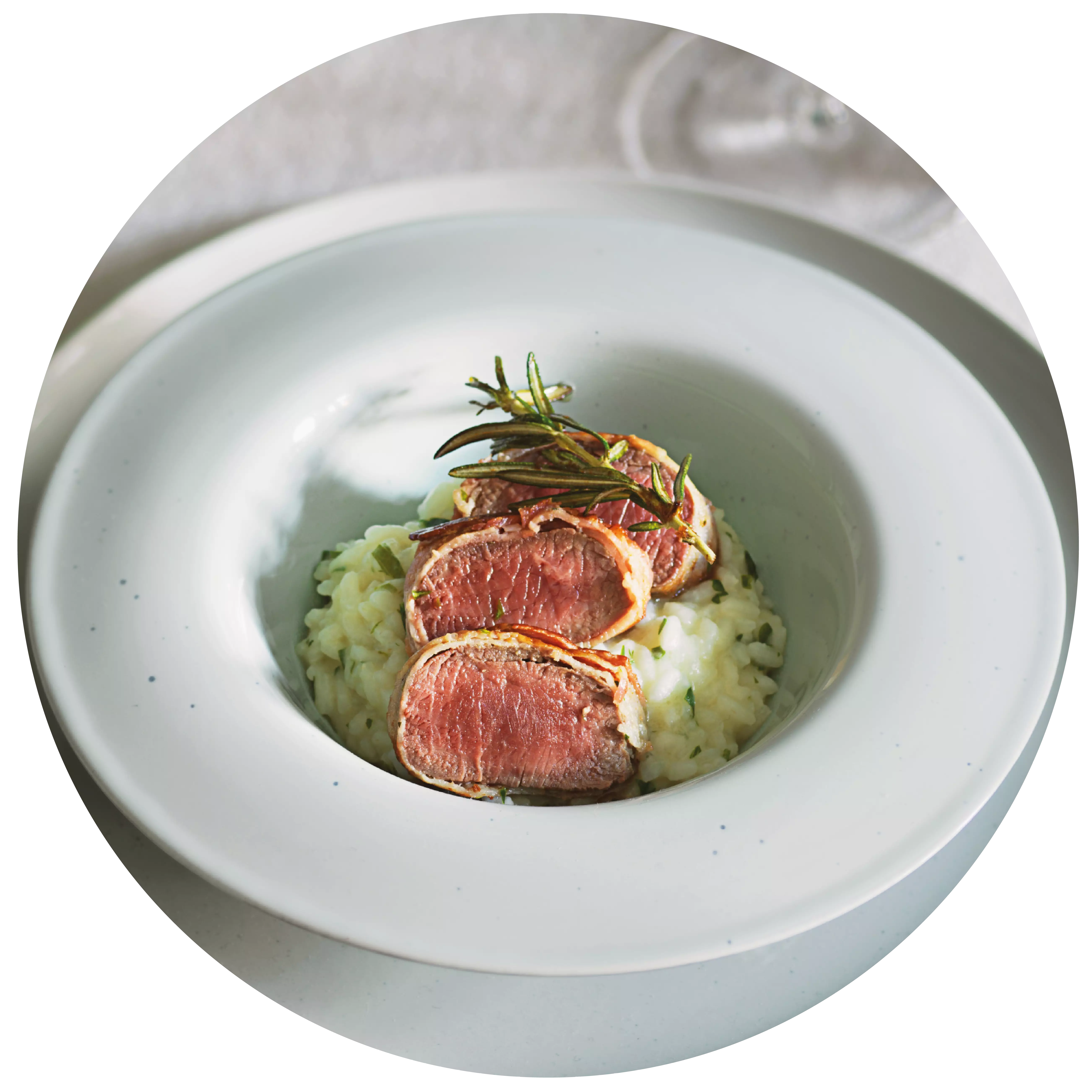
with fresh chanterelles Autumn bruschetta
with fresh chanterelles
- 4 Ciabatta-Brötchen
- 200 Gramm kleine Pfifferlinge
- 4 EL kleingehackte Petersilie
- 4 Zehen Knoblauch
- 80 Gramm Pecorino (Hartkäse)
- 8 EL kaltgepresstes Olivenöl
- Eine Prise Salz & Pfeffer
Preheat the oven to 200 degrees.
Clean the chanterelles. Sauté the parsley in a pan with half of the oil, then add the mushrooms and cook over a low heat for approx. 5 minutes.
Slice the rolls and bake for approx. 5 minutes until crispy.
Chop the garlic into small pieces, spread on the warm bread rolls and drizzle with the other half of the oil. Coarsely grate the pecorino.
Stir the chanterelle and parsley mixture into the pecorino and spread over the halves of the rolls.
- Pinot Gris (trocken)
- Federweißer (brut nature)

with pumpkin and white wine sauce Pasta with pumpkin and white wine sauce
with pumpkin and white wine sauce
- 750 Gramm Butternut-Kürbis(se)
- 3 kleine Zwiebeln
- 2 Zehen Knoblauch
- 1 Becher Crème fraîche
- 250 ml trockener Weißwein
- 500 ml Gemüsebrühe
- 25 Gramm Parmesan oder ähnlicher Hartkäse
- 400 Gramm Spaghetti oder andere Nudeln
- nach Geschmack Salz, Pfeffer, Zucker
- 4 EL Kürbiskerne, evtl. gehackt
- nach Belieben Muskat, Thymian
Sauté the garlic and onions until translucent. Dice the butternut squash and add, season with pepper and sugar. When the cubes are still firm, pour in the white wine and vegetable stock. Continue cooking until the squash is firm to the bite.
In the meantime, cook and drain the pasta.
Add the thyme, nutmeg, salt and crème fraîche to the boiling pumpkin, bring to the boil and thicken. Stir in the parmesan and season to taste. You can also crush some diced pumpkin to make the sauce sweeter.
Arrange the pasta on plates and top with the pumpkin sauce.
Sprinkle with pumpkin seeds.
- Scheurebe (trocken)
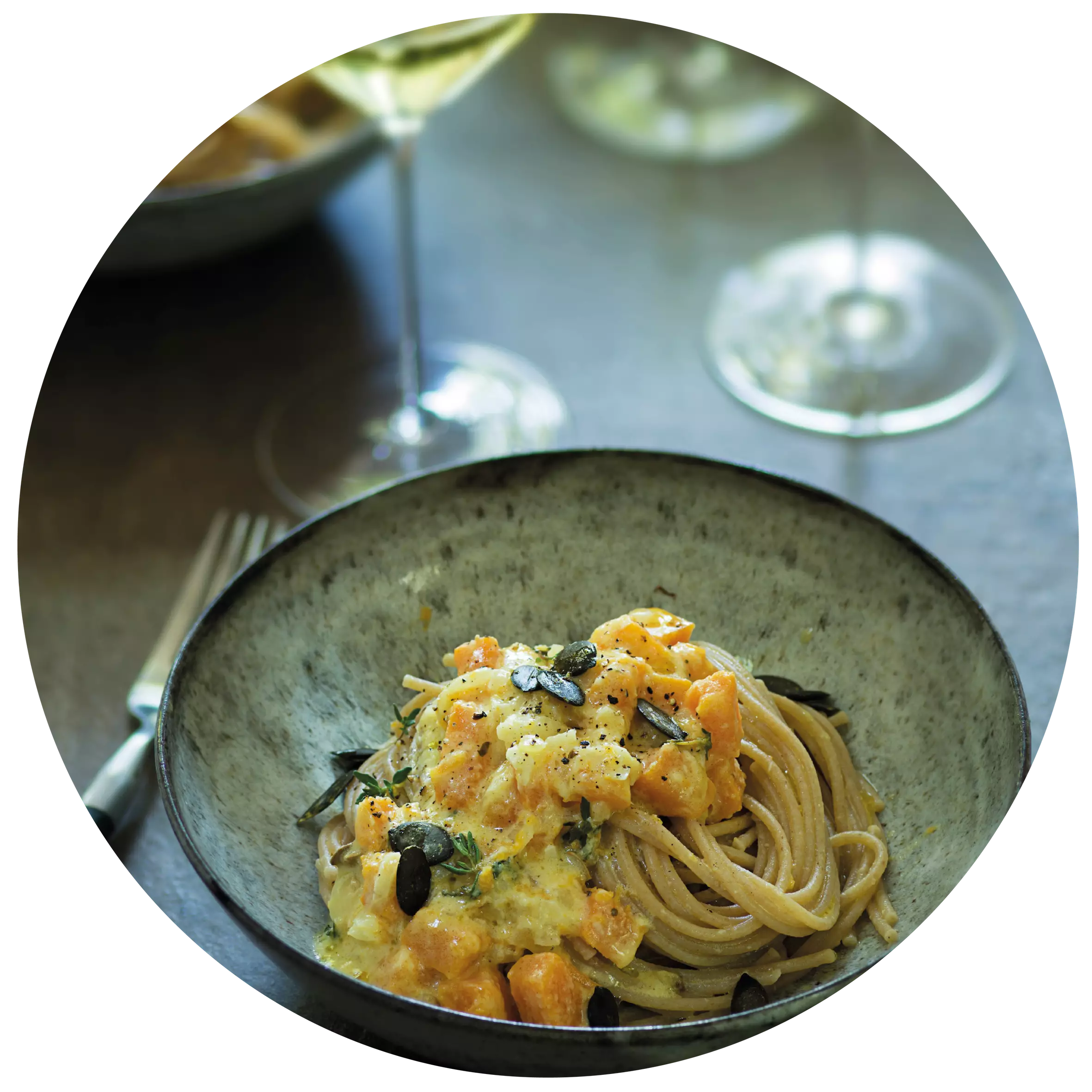
with dry sparkling wine Sparkling wine and lime dessert
with dry sparkling wine
- 300ml Winzersekt
- 4 Limetten
- 100g Zucker
- 30g Speisestärke
- 100g Butterkekse
- 50g ungesalzene Butter
- 2 Eiweiße
- 50g grieschicher Joghurt
- 150g Schlagsahne
Pour the sparkling wine and sugar into a pan. Chill the remaining sparkling wine. Wash 1 lime with hot water and finely grate the zest. Halve the lime and 2 others, squeeze out the juice and mix with the cornflour. Pour everything into the pan and bring to the boil briefly. Remove the pan from the heat and chill the cream in the fridge.
Fill the shortbread biscuits into a freezer bag, crush with a rolling pin and place in a bowl. Melt the butter in a pan, pour over the crumbled shortbread biscuits, add a pinch of salt and mix well. Leave to cool briefly, divide half into large wine glasses and press down firmly.
Cut the lime into slices. Beat the egg whites with salt until stiff. Stir the yoghurt into the chilled champagne and lime cream. Whip the cream until stiff and fold into the cooled cream, one after the other, together with the beaten egg whites. Spread half over wine glasses, add another layer of shortbread biscuits and finish with a layer of cream. Garnish with lime slices and pour in the remaining sparkling wine. Toast and enjoy!
- Riesling (trocken)
- Pinot Blanc (trocken)
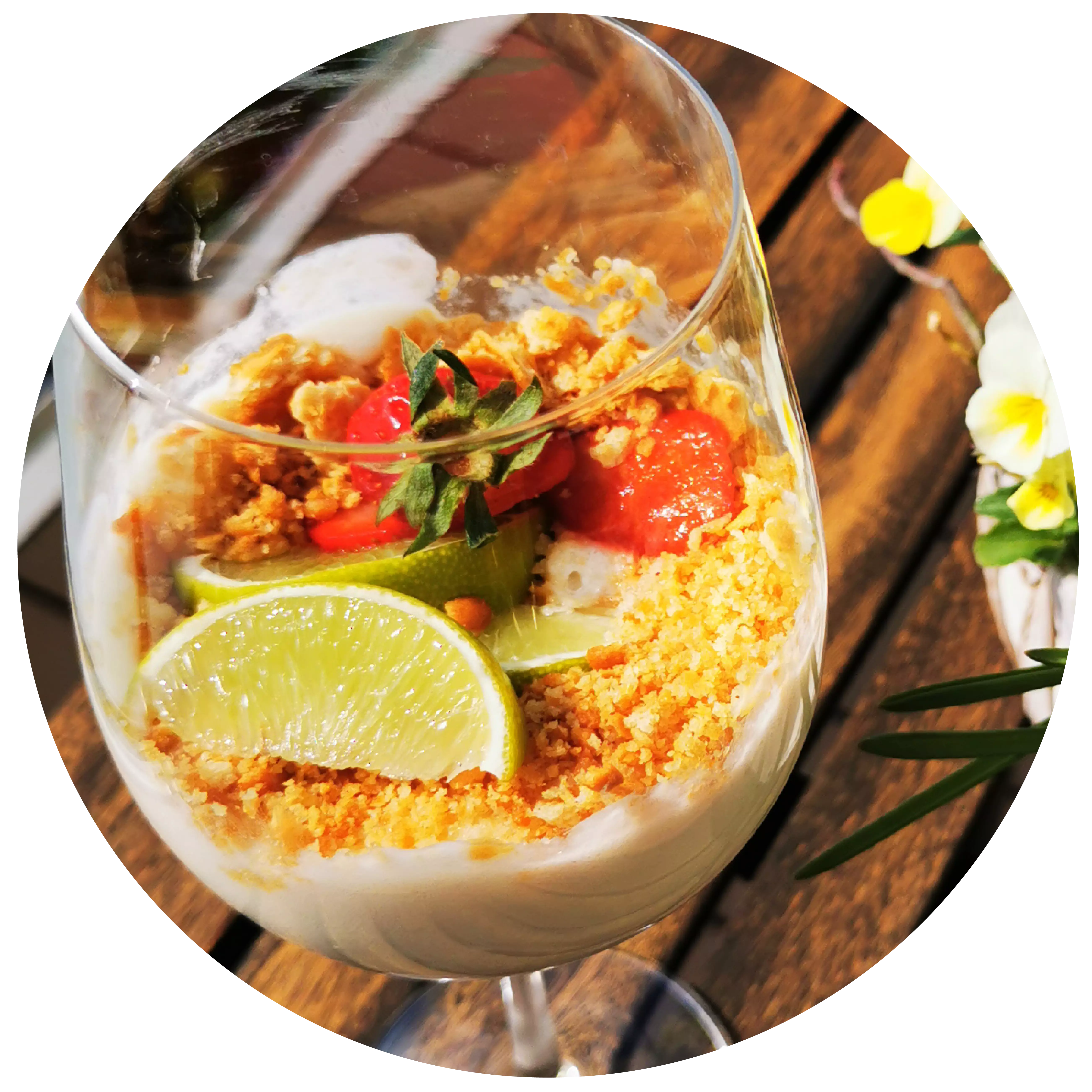
Events
-
Show
winetasting in our winery - cheese & wine
Mainz-Hechtsheim


